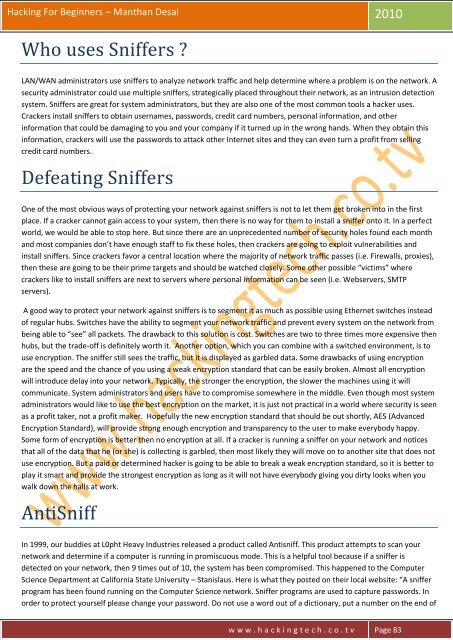Legal Disclaimer
Hacking-For-Beginners-a-beginners-guide-for-learning-ethical-hacking
Hacking-For-Beginners-a-beginners-guide-for-learning-ethical-hacking
- No tags were found...
You also want an ePaper? Increase the reach of your titles
YUMPU automatically turns print PDFs into web optimized ePapers that Google loves.
Hacking For Beginners – Manthan Desai 2010<br />
Who uses Sniffers ?<br />
LAN/WAN administrators use sniffers to analyze network traffic and help determine where a problem is on the network. A<br />
security administrator could use multiple sniffers, strategically placed throughout their network, as an intrusion detection<br />
system. Sniffers are great for system administrators, but they are also one of the most common tools a hacker uses.<br />
Crackers install sniffers to obtain usernames, passwords, credit card numbers, personal information, and other<br />
information that could be damaging to you and your company if it turned up in the wrong hands. When they obtain this<br />
information, crackers will use the passwords to attack other Internet sites and they can even turn a profit from selling<br />
credit card numbers.<br />
Defeating Sniffers<br />
One of the most obvious ways of protecting your network against sniffers is not to let them get broken into in the first<br />
place. If a cracker cannot gain access to your system, then there is no way for them to install a sniffer onto it. In a perfect<br />
world, we would be able to stop here. But since there are an unprecedented number of security holes found each month<br />
and most companies don’t have enough staff to fix these holes, then crackers are going to exploit vulnerabilities and<br />
install sniffers. Since crackers favor a central location where the majority of network traffic passes (i.e. Firewalls, proxies),<br />
then these are going to be their prime targets and should be watched closely. Some other possible “victims” where<br />
crackers like to install sniffers are next to servers where personal information can be seen (i.e. Webservers, SMTP<br />
servers).<br />
A good way to protect your network against sniffers is to segment it as much as possible using Ethernet switches instead<br />
of regular hubs. Switches have the ability to segment your network traffic and prevent every system on the network from<br />
being able to “see” all packets. The drawback to this solution is cost. Switches are two to three times more expensive then<br />
hubs, but the trade-off is definitely worth it. Another option, which you can combine with a switched environment, is to<br />
use encryption. The sniffer still sees the traffic, but it is displayed as garbled data. Some drawbacks of using encryption<br />
are the speed and the chance of you using a weak encryption standard that can be easily broken. Almost all encryption<br />
will introduce delay into your network. Typically, the stronger the encryption, the slower the machines using it will<br />
communicate. System administrators and users have to compromise somewhere in the middle. Even though most system<br />
administrators would like to use the best encryption on the market, it is just not practical in a world where security is seen<br />
as a profit taker, not a profit maker. Hopefully the new encryption standard that should be out shortly, AES (Advanced<br />
Encryption Standard), will provide strong enough encryption and transparency to the user to make everybody happy.<br />
Some form of encryption is better then no encryption at all. If a cracker is running a sniffer on your network and notices<br />
that all of the data that he (or she) is collecting is garbled, then most likely they will move on to another site that does not<br />
use encryption. But a paid or determined hacker is going to be able to break a weak encryption standard, so it is better to<br />
play it smart and provide the strongest encryption as long as it will not have everybody giving you dirty looks when you<br />
walk down the halls at work.<br />
AntiSniff<br />
In 1999, our buddies at L0pht Heavy Industries released a product called Antisniff. This product attempts to scan your<br />
network and determine if a computer is running in promiscuous mode. This is a helpful tool because if a sniffer is<br />
detected on your network, then 9 times out of 10, the system has been compromised. This happened to the Computer<br />
Science Department at California State University – Stanislaus. Here is what they posted on their local website: “A sniffer<br />
program has been found running on the Computer Science network. Sniffer programs are used to capture passwords. In<br />
order to protect yourself please change your password. Do not use a word out of a dictionary, put a number on the end of<br />
w w w . h a c k i n g t e c h . c o . t v Page 83



